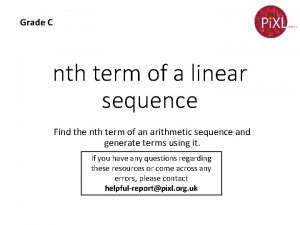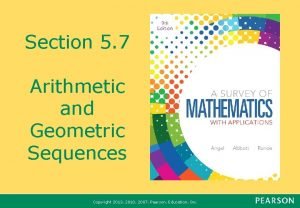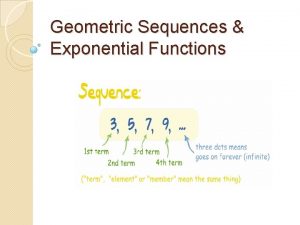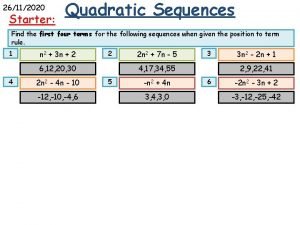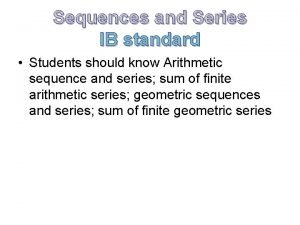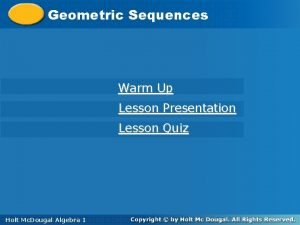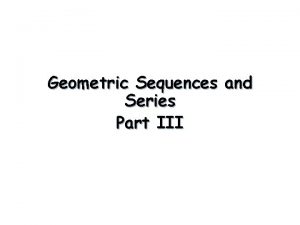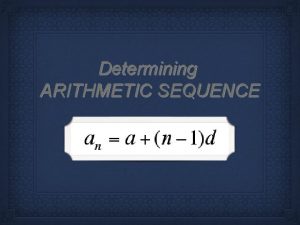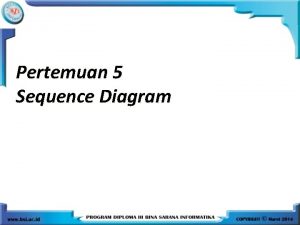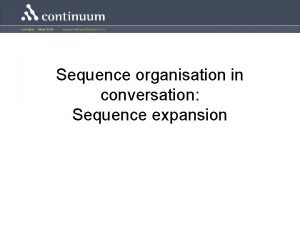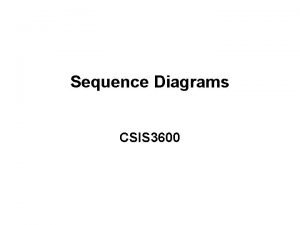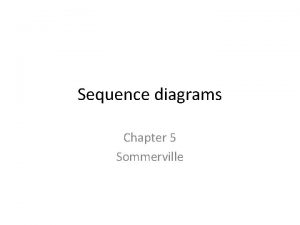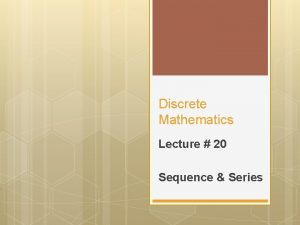Grade C nth term of a linear sequence















- Slides: 15

Grade C nth term of a linear sequence Find the nth term of an arithmetic sequence and generate terms using it. If you have any questions regarding these resources or come across any errors, please contact helpful-report@pixl. org. uk

Key Vocabulary Sequence Term nth term Linear sequence Arithmetic sequence Common difference

How to generate the first 5 terms of a sequence from the nth term n represents the position 1) 4 n + 5 number, so for the first 5 terms n = 1, 2, 3, 4 & 5 When n = 1 4 x 1 + 5 = 9 When n = 2 4 x 2 + 5 = 13 When n = 3 4 x 3 + 5 = 17 When n = 4 4 x 4 + 5 = 21 When n = 5 4 x 5 + 5 = 25 So the first 5 terms are 9, 13, 17, 21, 25

How to generate the first 5 terms of a sequence from the nth term 2) 3 n – 7 n represents the position number, so for the first 5 terms n = 1, 2, 3, 4 & 5 When n = 1 3 x 1 – 7 = – 4 When n = 2 3 x 2 – 7 = – 1 When n = 3 3 x 3 – 7 = 2 When n = 4 3 x 4 – 7 = 5 When n = 5 3 x 5 – 7 = 8 So the first 5 terms are – 4 , – 1 , 2, 5, 8

Now you try… Write down the first 5 terms of the sequence whose nth term is given by: a)8 n + 1 b)6 n – 5 c)5 n – 12 d)11 – 2 n e)4 – 3 n 9, 17, 25, 33, 41 1, 7, 13, 19, 25 – 7, – 2, 3, 8, 13 9, 7, 5, 3, 1 1, – 2, – 5, – 8, – 11

A linear or arithmetic sequence is where the terms increase or decrease by the same number. This is known as the common difference Look at these sequences 6, 13, 20, 27, 34 Common difference of +7 12, 10, 8, 6, 4 Common difference of – 2 Both sequences are linear/arithmetic because they have the same common difference

How to find the nth term of a linear/arithmetic sequence 1) 6, 10, 14, 18, 22 +4 +4 The sequence increases by 4, so the nth term starts with 4 n Now compare the sequence to the 4 times table 6, 10, 14, 18, 22 +2 +2 +2 4, 8, 12, 16, 20 Each term is 2 bigger than the 4 times table So the nth term is 4 n + 2

How to find the nth term of a linear/arithmetic sequence 2) 5, 14, 23, 32, 41 +9 +9 The sequence increases by 9, so the nth term starts with 9 n Now compare the sequence to the 9 times table 5, 14, 23, 32, 41 – 4 – 4 – 4 9, 18, 27, 36, 45 Each term is 4 smaller than the 9 times table So the nth term is 9 n – 4

How to find the nth term of a linear/arithmetic sequence 3) 15, 9, 3, – 9 – 6 – 6 The sequence decreases by 6, so the nth term starts with – 6 n Now compare the sequence to the – 6 times table 15, 9, 3, – 9 +21 +21 +21 Each term is 21 bigger than the – 6 times table – 6, – 12, – 18, – 24, – 30 So the nth term is – 6 n + 21

Now you try, write down an expression in terms of n for these linear sequences: a) 8, 11, 14, 17, 20 3 n + 5 8 n – 6 b) 2, 10, 18, 26, 34 7 n – 15 c) – 8, – 1, 6, 13, 20 d) 4, 1, – 2, – 5, – 8 – 3 n + 7 e) – 6, – 8, – 10, – 12, – 14 – 2 n – 4

For each sequence, find an expression for the nth term and the value of the 20 th term: a) 11, 15, 19, 23, 27 nth term: 4 n + 7 20 th term, n = 20 4 x 20 + 7 = 87 b) – 1, 7, 15, 23, 31 nth term: 8 n – 9 20 th term, n = 20 8 x 20 – 9 = 151

Sequences from Patterns Here are three patterns using circles (a) Draw pattern 4 (b) Write down an expression for the nth pattern (c) How many circles are in the 50 th pattern Pattern 1 Pattern 2 Pattern 3

Solution Pattern 1 (a) Pattern 4 Pattern 2 Pattern 3 (b) The nth term The number of circles in each pattern forms a linear sequence 3, 5, 7, 9 nth term: 2 n + 1 (c) Number of circles in the 50 th term nth term: 2 n + 1 and n = 50 101 circles in 2 x 50 + 1 = 101 50 th pattern

Problem Solving and Reasoning Here are the first 5 terms of an arithmetic sequence: 3, 10, 17, 24, 31 Show that 220 is in the sequence. nth term: 7 n – 4 Remember n represents the position number of the sequence. Therefore n must be an integer. Form the equation 7 n – 4 = 220 So 220 is the 32 nd term in the sequence 7 n = 224 ÷ 7 n = 32

Problem Solving and Reasoning Kelly has £ 200 in her Post Office savings account. Each month she will add an extra £ 15 to the account. Kelly wants to save more than £ 480. How long will this take? Here is the sequence: 215, 230, 245, 260, 275. . . nth term is 15 n + 185 We want more than £ 480 So we need to solve the following inequality 15 n + 185 > 480 15 n > 295 ÷ 15 n > 19. 6667 Because n is an integer it will take Kelly 20 months to save over £ 480.
 How to find the nth term
How to find the nth term How to write a geometric sequence
How to write a geometric sequence Geometric rule
Geometric rule Geometric series sum
Geometric series sum Nth term of a sequence
Nth term of a sequence Exponential geometric sequence
Exponential geometric sequence Quadratic sequences examples
Quadratic sequences examples Arithmetic sequence diagram
Arithmetic sequence diagram Sequences and series
Sequences and series Geometric sequence formula for the nth term
Geometric sequence formula for the nth term Geometric progression
Geometric progression Geometric recursive formula
Geometric recursive formula Nth term formula
Nth term formula Nth term test
Nth term test Nth term rule
Nth term rule Nth term starter
Nth term starter
